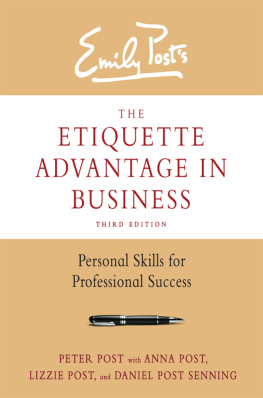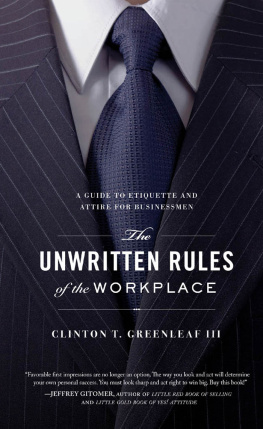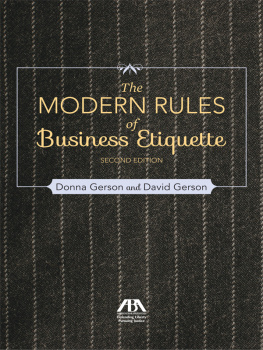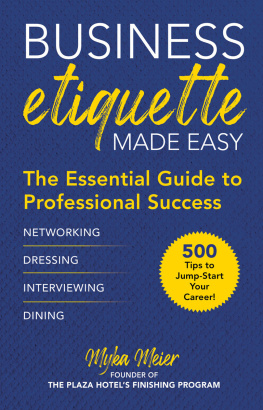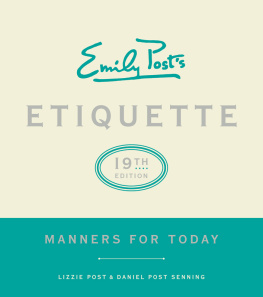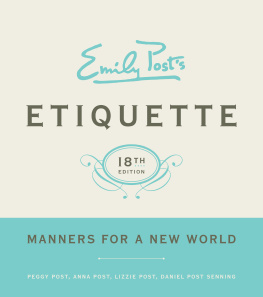WE DEDICATE THIS BOOK TO PEGGY POST
who has in turn dedicated more than twenty years as an author, spokesperson, seminar presenter, columnist, and director of The Emily Post Institute. During this time she has carried on the tradition of bringing etiquette to America that began with Emily Post in 1922.
Peggys dedication to the Institute and to making peoples lives more pleasant has been instrumental in raising peoples awareness of and interest in etiquette. Peggy has been a wonderful mentor to the next generation as they prepare to take up the mantle of Emily Post.
While this is the third edition of The Etiquette Advantage in Business, we could not have gotten here without the help and support of people who contributed to the first and second editions. Fred DuBose and Royce Flippin were instrumental in helping make those two editions successful with both their writing and editing skills.
Thanks to all who helped with research and great ideas for the first and second editions: Courtney Denby, Inge Dobelis, Martha Leslie Hailey, Tad Harvey, Beth Landis, Alexis Lipsitz, Dierdre Van Dyk, Bryce Walker, Regis Canning, Lois Ebin, John Fowler, Greg Gregory, Dr. Judy Harkins, Mimi Irwin, Nancy Maniscalco, Knox Massey, James B. Miller Jr., Bob Moore, Susan Onaitis, Morgan Rich, and Evan P. Spingarn.
For their critical eye editing the first and second editions, thanks go to: Linda Ambrose, Keith Anderson, Kate DuBose, Stacy Kravetz, Kenneth Santor, and Burke Stinson.
Our warmest appreciation to Tricia Post for overseeing the rewrite process for the third edition. Tricia is the behind-the-scenes writer and editor at The Emily Post Institute.
We also want to extend a special thank you to Emily Krump, our editor at HarperCollins, who has worked doggedly to keep us on track and to make this, the third edition, the best edition yet.
At The Emily Post Institute weve often discussed if we got the title of this book wrong. Perhaps the subtitle, Personal Skills for Professional Success, is a better, more descriptive one. That, after all, is what the book is really abouthow you can achieve success in your business life.
Our own experience teaching business etiquette over the years has given us a deep appreciation of Emily Posts belief that everyday manners and workplace manners are inseparable. Just as people everywhere strive for pleasant personal encounters, people in business want and need standards of behavior that make their professional relationships smooth, enjoyable, and productive. Knowing the best way to behave can make all the difference between getting ahead... and getting left behind.
Your personal skills are what help you forge good business relationships, and relationships are at the heart of business etiquette. Not rules; not which fork you use, or if you called someone by their first name instead of their title and last name, or put paper in the photo copier when it ran out, or cleaned your dishes and wiped the table after finishing your lunch in the office cafeteria.
Knowing how to behave in a wide variety of professional settings not only makes you a more pleasant, confident, and enjoyable person to work with, but it also provides you with the all-important tools for building solid, productive relationships with your business associatesrelationships that will help propel you and your company toward your mutual goals. Given todays greater job mobility, the growing popularity of the team concept in business, and the increased need to take different cultural and generational sensitivities into account in a global marketplace, your personal skills are now, more than ever, the key to your professional success, and it is etiquette that helps you build relationships.
The goal of The Etiquette Advantage in Business is to help you develop the self-assurance that comes with knowing not just what to do but also why that behavior is appropriate. Throughout this book, our advice is grounded in etiquettes bedrock principles of consideration, respect, and honesty and how these inform and guide what others consider good manners. With this knowledge, you will be able to judge for yourself what constitutes correct behavior in any given situation.
WHAT YOULL FIND
Reflecting the ever-accelerating pace of business, this revised edition of The Etiquette Advantage in Business has been extensively reviewed and updated to reflect the realities of todays business world, particularly as it strives to integrate digital life into the workplace.
In 1999, The Etiquette Advantage in Business was written to address a major issue in the workplace: incivility. Incivility alone wouldnt have warranted the book, but the growing frustration of workers about incivility did. Employees were no longer willing to be silent about being treated rudely. A survey in 2000 revealed how serious the issue had become: more than 50 percent of workers had been treated rudely. As a result, 22 percent of them were decreasing their work effort and 12 percent were leaving their jobs because of it. Profits and productivity were directly being affected by incivility on the workplace.
At the same time technology was having a major impact on how people communicated. With the advent of the desktop computer, executives no longer had assistants typing memos, letters, and reports from dictation. They were crafting emails and using word processors to create their own documents, and in doing so they were making mistakes in tone, grammar, and proofing that directly affected business in a negative way. Likewise cell phones began to impact relationships as businesspeople used them in ways that was perceived by others as rude.
Six years later, the second edition of The Etiquette Advantage in Business focused on the changing attitudes toward a more informal workplace. Casual dress, teams, home offices, cubicle areas, and open office relationships between managers and employees all fostered this more informal workplace. A new generationmillennialswas about to make its presence felt on the scene just as the workplace was coming to grips with the different ideas and attitudes that Gen Xers brought with them into the business world. Technology continued to be a boon to the workplace. However, as more work could be done by fewer people, technology made it possible for businesspeople to be available 24/7, rather than merely from nine to five. Email communication and inappropriate use of cell phones continued to demand special attention.
While all three editions are written for businesspeople of all types, levels, and backgroundsincluding office workers, those who work at home, and executives who regularly do business overseasthe third edition pays special attention to the fact that for the first time in history four generations are actively working side by side in the workplace. Learning how to interact with people from generations other than your own is key to being successful in business today. For instance, a fifty-something baby boomer may find himself working for a twenty-four-year-old millennial dot-com start-up owner. They both need to consider carefully their respective attitudes toward the work environment, means of communicating, comfort with technology, and even the importance of work compared to personal time.
The third edition also brings added emphasis to the growth of digital communication and social networking. Texting, tweeting, blogging, LinkedIn, Facebook, and even Pinterest now can be used to build relationships or be abused and hurt relationships and even cost people their jobs. Smartphones have supplanted cell phones with their added capabilities to surf the Internet and communicate by email and text, bringing another level of distraction and interruption to face-to-face interactions.

